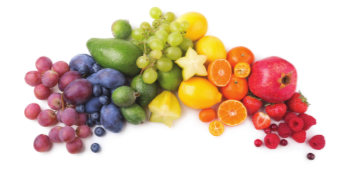Eat the Rainbow of Fruits and Vegetables
go.ncsu.edu/readext?933376
en Español / em Português
El inglés es el idioma de control de esta página. En la medida en que haya algún conflicto entre la traducción al inglés y la traducción, el inglés prevalece.
Al hacer clic en el enlace de traducción se activa un servicio de traducción gratuito para convertir la página al español. Al igual que con cualquier traducción por Internet, la conversión no es sensible al contexto y puede que no traduzca el texto en su significado original. NC State Extension no garantiza la exactitud del texto traducido. Por favor, tenga en cuenta que algunas aplicaciones y/o servicios pueden no funcionar como se espera cuando se traducen.
Português
Inglês é o idioma de controle desta página. Na medida que haja algum conflito entre o texto original em Inglês e a tradução, o Inglês prevalece.
Ao clicar no link de tradução, um serviço gratuito de tradução será ativado para converter a página para o Português. Como em qualquer tradução pela internet, a conversão não é sensivel ao contexto e pode não ocorrer a tradução para o significado orginal. O serviço de Extensão da Carolina do Norte (NC State Extension) não garante a exatidão do texto traduzido. Por favor, observe que algumas funções ou serviços podem não funcionar como esperado após a tradução.
English
English is the controlling language of this page. To the extent there is any conflict between the English text and the translation, English controls.
Clicking on the translation link activates a free translation service to convert the page to Spanish. As with any Internet translation, the conversion is not context-sensitive and may not translate the text to its original meaning. NC State Extension does not guarantee the accuracy of the translated text. Please note that some applications and/or services may not function as expected when translated.
Collapse ▲I like to eat fruits and vegetables, but I think I might scream the next time
I’m told that the vegetable of the day is broccoli or California medley. I like
these vegetables and will eat them if they’re the only choice. I know these
veggies are easy to get, store and are relatively inexpensive…but
please…get more creative! We’re wanting people to eat more fruits and
vegetables, but it’s hard to do when we limit our choices or preferences.
You may wonder what is the healthiest fruit or vegetable to eat. Meredith
McGrath, RD, LDN answered this question in a blog post. McGrath is a
dietitian for Redner’s Markets in Pennsylvania, Maryland and Delaware.
She frequently writes in the Produce for Better Health blog.
She says she loves the question about the healthiest fruit or vegetable
because it’s easy to answer….ALL of them.
She goes on to say that the key is to eat a variety of fruits and vegetables
because they are nutrient dense foods. The major nutrients found in fruits
and vegetables are calcium, fiber, folate, iron, magnesium, potassium, sodium, vitamin A and Vitamin C. All of this with little or no added sugars,
saturated fat or sodium. Obviously the amounts of these differ with
different fruits and/or vegetable.
If you only eat bananas or broccoli you’re missing out on the nutrients that
are provided by other fruits and vegetables such as apples, carrots and
berries. We all know we should be more fruits and vegetables, but we also
need to push ourselves to eat more variety. It doesn’t matter if the fruits
and vegetables you’re eating are fresh, canned, frozen or dried, you’re still
getting the nutrients.
McGrath also shares that not only is there a difference in vitamins and
minerals among fruits and vegetables, but they also contain different
compounds called phytochemicals. The term phytonutrients is a broad
name for a wide variety of compounds produced by plants. They’re found
in fruits, vegetables, beans, grains, and other plants. Each phytonutrient
comes from a variety of different plant sources and has different proposed
effects on, and benefits for, the body. Some researchers estimate there are
up to 4,000 phytonutrients. Scientists have identified thousands of them,
although only a small fraction of phytonutrients have been studied closely.
New experimental studies are emerging that demonstrate multiple effects
of fruits and vegetables and their phytonutrients. This suggest that that
they may have an even greater role to play in human health than the
positive things we already know.
As a way of getting these needed nutrients and phytochemicals, McGrath
suggests seeking out (and eating) fruits and vegetables with a variety of
colors. Each color provides different nutrients and phytochemicals that aid
our bodies in different ways.
Orange and Dark Green leafy vegetable such as pumpkin, sweet potato,
carrots, cantaloupe, apricots, spinach, collard greens, kale and broccoli
contain beta-carotene. This phytochemical benefits the immune system,
vision, skin health and bone health.
Red fruits and vegetables such as watermelon, tomatoes, pink grapefruit
and red peppers contain lycopene. This phytochemical is thought to reduce
the risk of prostate cancer and heart health.
Green vegetables such as collard greens, kale, spinach, broccoli, Brussels
sprouts, lettuces and artichokes have the phytochemical lutein. It’s known
for eye and heart health and reducing the risk of cancer.
Purple, blue and red foods such as blueberries, blackberries, plums,
cranberries, raspberries, red onions, red potatoes, red radishes and
strawberries contain anthocyanidins. This phytochemical is thought to
effect blood vessel health.
You don’t really need to remember which nutrient or phytochemical is in
each fruit or vegetable or what they do…just remember that variety is the
key. Eat lots of them.
You can view McGrath’s original blog post at Fruits and Veggies
where she also has suggestions for a day full of colorful meals.
Syracuse is a Family and Consumer Science team member and can be
reached at NC State Extension, Brunswick County Center 910-253-
2610 or by email at Cheryle_Syracuse@ncsu.edu




